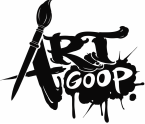|
1. Who were your teachers or influences?
Although I knew from a very early age that I wanted to be an artist, after spending less than a semester at both the Pennsylvania Academy of the Fine Arts and the School of Visual Arts, I decided that formal training wasn't for me. Hence, I can't credit any teachers, in the strictly academic sense of the word. As a teen I read a lot of books on art (and still do), and that, along with trial and error, is how I first learned to oil paint. Additionally, I've been very fortunate in my career to have been around and learned from many truly great artists, especially Ron English, for whom I worked as a painting assistant. My taste is actually pretty varied, and I have favorites from nearly every art movement. This may be surprising to some, but I also feel equally visually inspired by filmmakers as much as painters – Alejandro Jodorowsky, David Lynch, and Dario Argento are a few influences, and the numerous fantasy films I obsessed over in my childhood have certainly had an impact on me as well. 2. What techniques or tricks did you find most useful when learning to paint? Employing grisaille technique when first learning to paint can be very beneficial because it simplifies the process by breaking down values first, apart from colors. 3. What are 3 key principles of making good art, in your opinion? For a work of art to be of merit, in my opinion, it has to have at least one of the following elements (and I'm listing these in order of what I feel is the least to most difficult to attain as an artist): 1. Strong visual impact (whether it be pleasing or distressing) 2. Something to communicate to the viewer 3. Innovation in aesthetic or technique 4. What are the most common mistakes that you see other artists make? I make plenty of mistakes of my own, so I'm probably not in a position to judge, but I will give my sincere thoughts on the matter. I have two opposing sides when answering this question – one comes from my experience as a gallerist, and the other as an artist, so I'll do this in two parts. As a gallerist: Setting unrealistic prices, especially when just starting out, and aggravating curators by missing deadlines and being otherwise unreliable. You really don't want to make a curator's already difficult job harder than need be; keep in mind that your goal should be to have your galleries as enthusiastic as possible about selling your work and showing you again. As an artist: Not remaining true to yourself, following trends, and basically creating the same piece over and over again. If your work isn't an ongoing investigation into your experiences, thoughts, or even your craft, then you're essentially just making home decor... and if what you're aiming to do is to simply to pump out a commodity, there are probably a lot more practical, and profitable, things you could devote your talents to than fine art. 5. Can you break your painting process down into 10 steps, or less, for us? 1. First comes developing the concept for the artwork. For me, this frequently materializes through reflecting on my own experiences, interpersonal relationships, and social dynamics in which I'm immersed, and from there begins to emerge a visual metaphor of sorts. Some of my inspiration also results from both examining the work of others throughout art history, and reflecting on my own art, and figuring out how I can expand upon previously touched on ideas. I usually will write down my thoughts immediately so that I don't forget anything (and at this point I've amassed a list of painting ideas so long that I'll never get around to actually executing all of them!). 2. Once I have a vision of the piece I want to create, and decide to move forward with it, I begin to make concept sketches and lay out the composition. Following that, I'll organize props and models, and will shoot reference photos. Often times I will either manipulate and collage these images digitally, or draw/paint directly on top of of the print-outs for further preliminary development of my concept. 3. I cut and prime my panel, after which I apply the drawing – first in pencil, then outlining it in acrylic, and laying a ground color over the entire surface. 4. How I proceed with my initial oil layer depends on piece. I will either apply my colors directly with an alla prima approach, or create a monochromatic underpainting (lately I've been using umbers for this layer, but much of my older work was done in a blue or green underpainting). If the latter is the method I'm using, then numerous thin color glazes are applied with linseed oil. For the majority of the painting process, I try to keep the work mid-level as far as values, then at very end apply my brightest highlights and darkest tones to give everything a final pop. Once my oil painting has dried, I apply a varnish. 5. The final step in my process is an inevitable plague of self doubt and critique of the artwork, which results in a dread of sending images to the gallery, and not wanting to show the painting at all... then trying to figure out ways in which I can make the next one better. And though it can be vexing, I think that never being satisfied with your own work is a key element in pushing yourself to evolve.
1 Comment
|
Art GoopArt Goop is a Q&A for artists by artists. We ask questions designed to examine the techniques and methods of some of the most inspiring artists working today. Categories
All
Archives
September 2017
|


 RSS Feed
RSS Feed